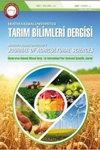A Variable Extractant Providing Method for On-The-Go Soil Nitrate Analysis Systems
IF 1.1
4区 农林科学
Tarim Bilimleri Dergisi-journal of Agricultural Sciences
Pub Date : 2016-08-25
DOI:10.1501/TARIMBIL_0000001403
引用次数: 0
Abstract
The objective of this study was to develop and test an automated extractant providing method utilizing pressurized air in a laboratory setting. Pressurized air was applied to extractant holder filled with extractant. An electro-pneumatic regulator valve was used to regulate the air pressure at 344.75, 551.6, and 758.45 kPa using an analog electrical signal. A two-position solenoid valve that was controlled via Labview software according to pre-specified time interval was used to provide a high pressure pulse at known durations to the extractant column inside the holder. The mass of extractant transported to the mixing unit during a single air pulse was measured and recorded for all treatments in the experimental design. Analysis of variance was performed to determine significance of each variable, namely pulse duration and air pressure. Step wise linear regression analysis was used to develop calibration models for the prediction of extractant mass. The only significant factor was pulse duration while pressure was insignificant (α= 0.05) on extractant mass for all treatments. Pulse duration was used to find a model to predict extractant mass, and provided a very good prediction (R2= 0.99) at fixed pressure setting. Laboratory test results proved that pressurized air was effective in obtaining known quantity of extractant. The electro-pneumatic method was capable of obtaining and transporting a precise amount of extractant needed for on-the-go soil nitrate analysis within a short time (less than 100 ms) with a coefficient of variation of less than 3%. It was concluded that the electro-pneumatic method was a viable candidate to be a precise variable extractant supply method for on-the-go soil analysis system.一种为动态土壤硝酸盐分析系统提供可变萃取剂的方法
本研究的目的是开发和测试一种在实验室环境中利用加压空气提供自动萃取剂的方法。将加压空气注入装满萃取剂的萃取器容器中。采用电-气调节阀,利用模拟电信号将气压调节为344.75、551.6、758.45 kPa。通过Labview软件根据预先指定的时间间隔控制一个双位置电磁阀,以已知的持续时间向支架内的萃取柱提供高压脉冲。在实验设计中,测量并记录了在单个空气脉冲中输送到混合单元的萃取剂的质量。进行方差分析以确定每个变量的显著性,即脉冲持续时间和气压。采用逐步线性回归分析建立萃取剂质量预测的标定模型。脉冲时间对提取剂质量影响不显著(α= 0.05),压力对提取剂质量影响不显著(α= 0.05)。使用脉冲持续时间来寻找预测萃取剂质量的模型,并在固定压力设置下提供了非常好的预测(R2= 0.99)。室内试验结果证明,加压空气能有效地获得已知量的萃取剂。电-气法能够在短时间内(小于100 ms)获得和输送精确数量的萃取剂,用于动态土壤硝酸盐分析,变异系数小于3%。结果表明,电-气法是一种适合于动态土壤分析系统的精确变量萃取剂供应方法。
本文章由计算机程序翻译,如有差异,请以英文原文为准。
求助全文
约1分钟内获得全文
求助全文
来源期刊
CiteScore
1.40
自引率
0.00%
发文量
26
期刊介绍:
Journal of Agricultural Sciences (JAS) is an international, double-blind peer-reviewed, open-access journal, published by the Faculty of Agriculture, Ankara University. The journal invites original research papers containing new insight into any aspect of Agricultural Sciences that are not published or not being considered for publication elsewhere. Preliminary, confirmatory or inconclusive research, review articles, case and local studies and works presenting taxonomy will not be published.

 求助内容:
求助内容: 应助结果提醒方式:
应助结果提醒方式:


